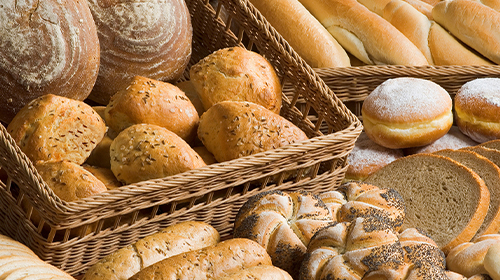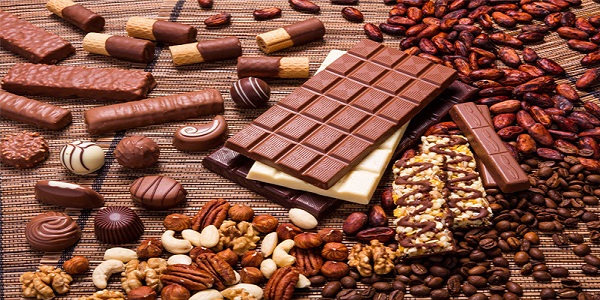Lecithin gives texture to food and optimises it
Lecithin has been used in food production for many years. Due to its good texture-giving properties, its harmlessness to health or even health-promoting properties in some cases and its unproblematic extraction and processing, lecithin is an important factor in the optimisation of food - from the production process to the product properties and the physiological value of the food. Lecithin is used wherever the emulsifying and dispersing properties of the substance offer advantages. Products that benefit most from it are, for instance, baked goods, confectionery and instant products.

Baked goods
Emulsifiers are indispensable in the bakery. With its excellent properties, lecithin can replace synthetic emulsifiers and, with good economic efficiency, is responsible for a number of product advantages, including:
- high volume yield
- improved freshness
- better dough properties
- optimised fat distribution
- increased fermentation tolerance
Baking Agents
The use of lecithin in baking agents strengthens the gluten network during dough preparation. In combination with proteins, lecithin offers improved water retention in the dough structure and thus improved freshness.
Patisserie
Lecithins in pastry products are responsible for a better distribution of the individual components, such as fat and sugar, in the mass. At the same time, they enable better processing properties and an even browning of the baked goods.
Waffles
In the production of waffles, lecithin is responsible for the finest distribution of the components. As a separating agent from the waffle iron, the structure of the waffle or the contours of the corrugation is very important, in addition to the pleasant browning. The use of lecithin also extends the cleaning intervals of the baking plates.
Yeast Pastry
Lecithin in yeast-raised doughs improves the extensibility of the adhesive. As a result, the fermentation stability increases, which leads to fine, even pores. Enzymatically hydrolysed lecithins are suitable for interrupting fermentation during the production of dough pieces. Due to their hydrophilic properties, they are able to bring the free dough water into small, fine, uniform ice crystals during freezing, thus protecting the adhesive framework and maintaining volume.
The wide range of applications also includes low-fat baked goods such as crackers or grissini, frozen doughs, cakes and cake mixes and pizza bases.
Chocolate and confectionery
The use of lecithin in chocolate masses enables the saving of cocoa butter, which is the most expensive raw material. Furthermore, lecithin influences the crystallisation behaviour of chocolate on the surface. With its single phospho-lipids, it adjusts the viscosity and the flow limits of the chocolate masses and thus supports the saving of energy and chocolate masses e.g., in coating masses. The use of lecithin fractions offers considerable savings in chocolate masses e.g., for ice cream coatings, chocolate candies and bar coatings, with uniform coating.
Typical applications for lecithin are, therefore:

- Chocolate bars
- Chocolate candies
- Hollowware
- Coating compounds
Instant products
Lecithin improves the dispersion ability of the individual powder forms. It shortens the sinking time and ensures a fine stable emulsion of the beverages. Furthermore, lecithins are also added during spray drying or during mixing. Here, lecithins that are enriched with PC or from whom oil has been removed, are advantageous because they are absolutely neutral in taste.
Lecithin is used for optimising:
- Cocoa drinks
- Milk shakes
- Protein shakes
- Milk powder
Margarine
The fat content of margarine in the “light margarine” category is approximately 40%. A major disadvantage is the splashing of the water content and the burning of protein components in the frying process. This can be positively influenced by an increased PC content, as also the development of smoke over a longer frying process. Enzymatically hydrolysed lecithins are also popular because they are very hydrophilic.
Lecithin improves margarine products:
- Stabilisation and emulsification of W/O emulsions
- Improvement in anti-oxidation
- Improved anti-splash behaviour
Vegetarian and vegan products
Vegetarian and vegan products? More versatile than ever!
Meat substitute products are gaining more and more popularity and volume. Manufacturers of alternative meat products have a large selection of raw materials and technologies as well as countless alternatives and opportunities. The texture and stability in the recipes of the meat alternative products are still considered to be special challenges.
Our lecithins offer you a plant-based solution
Lecithin serves as
- Emulsifier
- Process support
- Stabilizer
- Egg yolk substitute
Further advantages:
- Plant-based
- Sustainable emulsifier
- Foam stabilizer
- Supporting effect in machinability
Many other applications in the food sector
If product properties, production processes or cost efficiency need to be optimised, lecithin can contribute to optimisation in many other food categories.
- Flavours
- Infant food
- Icecream
- Colorants
- Meat broths and sauces
- Cocoa powder
- Chewing gum
- Cheese products
- Sugar and confectionery products



